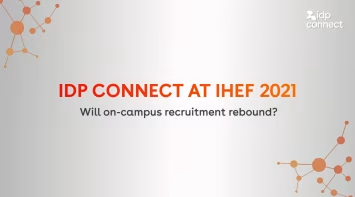How well is your institution known in target markets? International students love Canada, but they don’t always know enough about our colleges and universities.
Canada’s education brand is strong in overseas markets. Our research confirms that Canada performs better than other leading destinations on several factors that have a significant influence on international students’ choice of destination, including safety, affordability, and availability of part-time work.
However, as you can see from the graphic below, our data also reveals that many Canadian universities and colleges are having trouble distinguishing themselves abroad. As much as “Canada” may be popular in key markets, educators can’t leverage this if they can’t make students aware of their brand in the first place. In this post, we offer some ideas for how to create effective institutional branding.
Reasons Students Choose Canada

When we compare the following two graphics, it’s clear that students are much more drawn to particular programs and institutions in Australia, the UK, and the US than they are to programs and institutions in Canada. Canada-bound students are much more likely to come here based on a general, positive idea of our country.
Given that they already have Canada’s reputation as a strength, Canadian colleges and universities that improve their institutional branding will be more able to compete on a high level with institutions in competitor countries.


To differentiate, you have to be different
It sounds incredibly simple, but far too many educational institutions do not create and communicate a distinct position in their marketing campaigns.
Consider this: One Gallup research project found that the mission, purpose or vision statements of over 50 US colleges of all types and sizes were extremely similar. And a while back in Canada, surveyed students told research firm Eduvation that regarding various Canadian universities’ marketing:
• “The viewbooks all look the same, just with different logos on them.”
• “All of them are just saying how good they are, but nothing else.”
• “How am I supposed to choose between them?”
The advantages of narrowing your focus
Many educators worry that if they stake out a particular, specific position in the marketplace, they will lose the interest of hundreds of prospective students because they have zoned in on a smaller audience.
Here’s the thing: they will lose some students’ interest. But it’s worth it, because they will also gain a deeper level of interest on the part of hundreds more students who would not otherwise have considered enrolling with them.
That’s because all students know that a university/college cannot be good at everything.
They know that most institutions say they offer “high quality” or “the highest standards” (or something similar).
Students also know which universities are considered “elite” (a very small number of institutions) and desirable because their degrees carry prestige.
Does that mean that students will simply apply to an elite university and hope for the best?
No.
Here’s why:
• Most students won’t be accepted to such universities – and most students know that.
• What’s more, there’s very often an institution or program that can deliver as great an outcome for them as an elite university – or even better.
• Increasingly, thousands of international students are searching for institutions and programs that directly, concretely, match their ambition for their careers.
• Many students accompany program and institution searches with the word “Canada.”
But they won’t know about your institution and its programs unless the positioning and creative is bold, targeted, and based on insights from data.
How data insights lower risk and increase the likelihood of success
Educators using IDP Connect data learn an incredible amount about their target markets and how their brands are perceived in them vis a vis the competition. With this knowledge, they can confidently create marketing campaigns that resonate with the students they most want to attract. Here are just some examples of insights that IDP data can provide about how your current branding is working – and how it could be tweaked:
• Where is your brand is performing well (i.e., in a certain country, region, or city)? What elements of your marketing in those areas can be replicated in other target markets?
• In which markets is there high demand for certain programs? Does your university have programs in this field? If not, can it develop them or adapt some existing courses?
• Which of your programs is not attracting many students in a certain market? It may be time to pull back on marketing that program and leading with another.
• Where, and for which programs, are your competitors doing well? What competitive advantages are they leading with in their messaging? Do you have those same advantages and could you communicate them better?
• Are there markets that simply don’t make sense to target anymore given low search volumes from them?
• Is your marketing attracting attention from rural areas or cities in a target country? Once you know that, you can more precisely allocate marketing budget for maximum effect.
What’s your strength?
Once you have data insights about how well or poorly your institution is doing in particular markets, it’s time to narrow down your positioning in these markets.
What is your institution best known for (or best at)? Its healthcare degrees? Your co-op program? Whatever it is, lead with it. “A rising tide floats all boats” is a saying that concisely summarizes the idea that if you lead with your strength, your other capabilities will also attract attention. Don’t worry about not promoting all things equally – there will be a way of shining light on more programs/advantages eventually, just not as the lead.
What messaging is necessary in certain markets?
Let’s say you’re recruiting in Vietnam or the Philippines. If you are, you know that it would be a missed opportunity to not highlight graduate outcomes, the PGWP, labour market gaps in Canada, and part-time work options. When you promote your program to students in these countries, make sure to link it to the careers it helps to launch.
How is your search traffic changing?
Are you noticing more interest in healthcare from certain countries, regions, or cities? At certain times of the year? You can reassess and restructure marketing campaigns based on the real-time data IDP provides.
Deep focus based on a single selling point
At the end of the day, investing in data provides confidence in marketing. It allows you to lock down positioning in different markets relative to the competition, and to adjust messaging throughout the year depending on how search traffic is trending.
For a great example of a strategy we can only assume is founded in data insights, check out the University of Alabama’s “Where Legends Are Made” branding campaign that focuses exclusively on graduate outcomes as a selling point.
Please feel free to reach out to chat with us about how IDP Connect can provide you with the data you need to recruit successfully in 2021 – and beyond! We’d love to hear from you.
You might like...

Changing Parental Perceptions and Motivations in the International Education Decision Making Process
Parents are now more concerned about graduate employment opportunities than distance from friends and family.

Growing Student Markets in Africa to Watch in the Next Decade
Source market population and economic growth are key factors

How High Cost of Living and Global Economic Instabilities are Affecting International Student Perceptions
Supporting and encouraging prospective students to do financial research and their sums.



